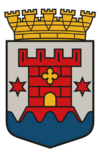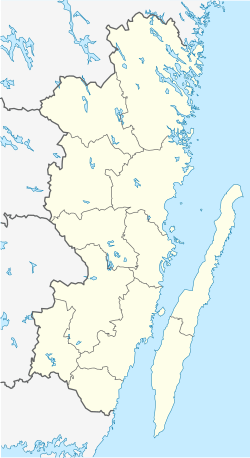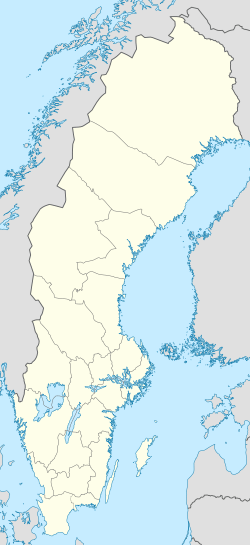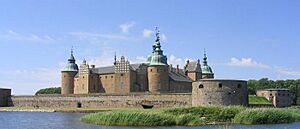Kalmar facts for kids
Quick facts for kids
Kalmar
|
||
|---|---|---|

Clockwise from top: aerial view of the Kalmar Cathedral, Kalmar Castle, the old water tower in central Kalmar, Öland Bridge and the water tower in Berga.
|
||
|
||
| Country | ||
| Province | Småland | |
| County | Kalmar County | |
| Municipality | Kalmar Municipality | |
| Charter | 1100 | |
| Area | ||
| • City | 19.50 km2 (7.53 sq mi) | |
| Elevation | 8 m (26 ft) | |
| Population
(2020)
|
||
| • City | 41,852 | |
| • Density | 1,866/km2 (4,830/sq mi) | |
| • Metro | 72,098 | |
| Time zone | UTC+1 (CET) | |
| • Summer (DST) | UTC+2 (CEST) | |
| Postal code |
39x xx
|
|
| Area code(s) | (+46) 480 | |
Kalmar is a city in the southeast of Sweden. It is located right by the Baltic Sea. In 2020, about 41,852 people lived there.
Kalmar is the main city of Kalmar Municipality and the capital of Kalmar County. This county includes 12 different towns. It is also the third largest city in the region of Småland.
For a long time, from the 1200s to the 1600s, Kalmar was one of Sweden's most important cities. It was a fortified city with the famous Kalmar Castle at its center. The city was also home to a bishop and the beautiful Kalmar Cathedral.
After 1658, Kalmar became less important for a while. But in the 1800s, new industries helped it grow again. Today, part of Linnaeus University is located in Kalmar. The city also hosts the Live at Heart festival, a big music event in Sweden.
Kalmar is close to the main road that leads to the island of Öland. You can reach Öland by crossing the Öland Bridge.
Contents
A Look Back at Kalmar's History
The area around Kalmar has been lived in for a very long time. People have found signs of Stone Age burial sites here. The first proof of a town in this spot dates back to the 1000s.
Kalmar's oldest city seal is from around 1255 to 1267. This makes it the oldest known city seal in all of Scandinavia.
Kalmar Castle and the Union
Around the 1100s, the first parts of a castle were built. It started as a round tower for guards and lookouts. This tower grew bigger in the 1200s.
In 1397, a very important meeting happened at Kalmar Castle. Queen Margaret brought together the leaders of Sweden and Norway. They signed the Kalmar Union treaty on July 13, 1397. This agreement created a union of the three Nordic kingdoms that lasted until 1523.
Kalmar was in a key spot near the Danish border. This made it important for trade and defense. Because of its location, the city was involved in many conflicts over the years.
In the 1540s, King Gustav Vasa and his sons worked on the castle. They rebuilt it into the amazing Renaissance castle you can see today.
Kalmar became a special church district in 1603. It kept this role until 1915. In 1634, Kalmar County was created, with Kalmar as its main city.
The building of the Kalmar Cathedral started in 1660. It was designed by Nicodemus Tessin the Elder. The cathedral was finally opened in 1703.
Kalmar faced many challenges, including the Kalmar War from 1611 to 1613. The castle was attacked many times, but it was never captured. After 1658, Kalmar's importance as a military outpost slowly decreased. This happened because Sweden's borders moved further south.
Kalmar Cathedral's Design
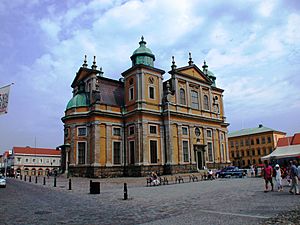
The new city of Kalmar was built on an island called Kvarnholmen in the mid-1600s. The move from the old town was mostly finished by 1658. The new, protected town was planned using popular Baroque styles.
The Kalmar Cathedral and the town hall face each other across the main square, Stortorget. The cathedral was designed by Nicodemus Tessin the Elder. It is a great example of Baroque classicism in Sweden. Its design shows how new styles, church needs, and the city's defense plans all came together.
Work on the cathedral began in 1660. However, it was stopped several times, especially during the Scanian War (1675–1679). Construction started again, and Kalmar Cathedral was completed in 1703.
Kalmar Today
In more recent times, Kalmar was known for its industries. Companies like Kalmar Verkstad made trains and large machines. A shipyard, Kalmar Shipyard, also operated here for many years. Volvo had a factory in Kalmar that built cars from 1974 to 1994.
Today, Kalmar is home to a large university with over 9,000 students. It also has a research center for the company Telia Sonera.
A Green City
Kalmar is working hard to reduce its use of fossil fuels. A local trucking company, for example, has cut its diesel use by 10 percent. They are now looking into using biodiesel for their trucks.
A big wood pulp plant in Kalmar uses the steam and hot water it used to waste. Now, this energy provides heating for homes through underground pipes. It also creates enough electricity to power its own operations and 20,000 homes.
Bicycle lanes are very common in Kalmar. You can even find a public biogas pump for cars in the city. New building rules require good thermal insulation and efficient windows for new homes. Street lights use energy-saving bulbs. Car dealers also promote fuel-efficient and hybrid vehicles.
Sports and Entertainment
In 2011, the Guldfågeln Arena was opened. This is the new stadium for the city's football team, Kalmar FF. The stadium can hold 12,000 people. It is one of the newest stadiums in Sweden. The arena also hosts concerts.
Kalmar's Climate
Kalmar has a climate with warm summers and fairly cold winters. Temperatures usually stay around zero degrees Celsius in winter. Kalmar is one of the warmest cities in Sweden. The highest temperature ever recorded here was 35.2°C (95.4°F).
| Climate data for Kalmar (2002–2020); extremes since 1901 | |||||||||||||
|---|---|---|---|---|---|---|---|---|---|---|---|---|---|
| Month | Jan | Feb | Mar | Apr | May | Jun | Jul | Aug | Sep | Oct | Nov | Dec | Year |
| Record high °C (°F) | 11.6 (52.9) |
17.0 (62.6) |
20.6 (69.1) |
25.7 (78.3) |
32.5 (90.5) |
33.0 (91.4) |
35.2 (95.4) |
33.1 (91.6) |
28.5 (83.3) |
23.5 (74.3) |
17.4 (63.3) |
13.2 (55.8) |
35.2 (95.4) |
| Mean maximum °C (°F) | 8.5 (47.3) |
8.7 (47.7) |
14.9 (58.8) |
18.9 (66.0) |
23.5 (74.3) |
27.2 (81.0) |
28.1 (82.6) |
27.2 (81.0) |
22.7 (72.9) |
17.6 (63.7) |
12.5 (54.5) |
9.2 (48.6) |
29.4 (84.9) |
| Mean daily maximum °C (°F) | 2.3 (36.1) |
2.8 (37.0) |
6.4 (43.5) |
11.4 (52.5) |
16.3 (61.3) |
20.6 (69.1) |
22.6 (72.7) |
22.1 (71.8) |
18.0 (64.4) |
11.9 (53.4) |
7.2 (45.0) |
3.9 (39.0) |
12.1 (53.8) |
| Daily mean °C (°F) | −0.5 (31.1) |
−0.2 (31.6) |
2.3 (36.1) |
6.2 (43.2) |
10.8 (51.4) |
15.1 (59.2) |
17.5 (63.5) |
16.9 (62.4) |
13.3 (55.9) |
8.3 (46.9) |
4.6 (40.3) |
1.3 (34.3) |
8.0 (46.3) |
| Mean daily minimum °C (°F) | −3.2 (26.2) |
−3.1 (26.4) |
−1.8 (28.8) |
1.0 (33.8) |
5.3 (41.5) |
9.6 (49.3) |
12.3 (54.1) |
11.7 (53.1) |
8.6 (47.5) |
4.6 (40.3) |
2.0 (35.6) |
−1.3 (29.7) |
3.8 (38.9) |
| Mean minimum °C (°F) | −14.9 (5.2) |
−13.8 (7.2) |
−10.0 (14.0) |
−5.2 (22.6) |
−1.7 (28.9) |
3.0 (37.4) |
6.6 (43.9) |
4.9 (40.8) |
1.2 (34.2) |
−3.8 (25.2) |
−6.7 (19.9) |
−11.4 (11.5) |
−17.7 (0.1) |
| Record low °C (°F) | −31.0 (−23.8) |
−26.5 (−15.7) |
−27.6 (−17.7) |
−12.7 (9.1) |
−5.8 (21.6) |
−1.2 (29.8) |
2.6 (36.7) |
0.4 (32.7) |
−5.7 (21.7) |
−8.8 (16.2) |
−17.3 (0.9) |
−25.3 (−13.5) |
−31.0 (−23.8) |
| Average precipitation mm (inches) | 36.3 (1.43) |
33.9 (1.33) |
27.1 (1.07) |
24.8 (0.98) |
37.8 (1.49) |
42.1 (1.66) |
75.3 (2.96) |
60.2 (2.37) |
32.9 (1.30) |
53.4 (2.10) |
57.1 (2.25) |
42.3 (1.67) |
523.2 (20.61) |
| Source 1: SMHI | |||||||||||||
| Source 2: SMHI Monthly Data 2002–2020 OGIMET | |||||||||||||
Images for kids
-
In 1972, the 6 km (4 mi) long Öland bridge was built from Kalmar to the town of Färjestaden on Öland
Sports Teams in Kalmar
Here are some sports clubs located in Kalmar:
- Kalmar FF
- Lindsdals IF
- Kalmar AIK
- IFK Berga
- IFK Kalmar
- Kalmar Södra IF
- Kalmar BTK
Famous People from Kalmar
Many notable people have come from Kalmar, including:
- Khamzat Chimaev – UFC Fighter
- Mikael Adolphson – historian
- Charlotta Djurström – theatre director
- Helena Josefsson – musician, lead singer in Sandy Mouche
- Ivar Kreuger – engineer and businessman
- Jangir Maddadi – designer living in Kalmar
- Carl Gustaf Mosander – chemist who discovered new elements
- Anna-Stina Nilstoft – painter
- Jenny Nyström – painter and illustrator
- Henrik Strindberg – composer
- Hans Villius – historian
Sister Cities Around the World
Kalmar is twinned with eleven cities. This means they have special friendly relationships:
 Árborg, Iceland
Árborg, Iceland Arendal, Norway
Arendal, Norway Entebbe, Uganda
Entebbe, Uganda Gdańsk, Poland
Gdańsk, Poland Kaliningrad, Russia
Kaliningrad, Russia Panevėžys, Lithuania
Panevėžys, Lithuania Samsun, Turkey
Samsun, Turkey Savonlinna, Finland
Savonlinna, Finland Silkeborg, Denmark
Silkeborg, Denmark Wilmington, United States
Wilmington, United States Wismar, Germany
Wismar, Germany
See also
 In Spanish: Kalmar para niños
In Spanish: Kalmar para niños


